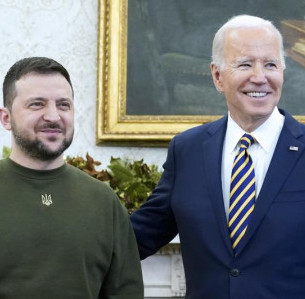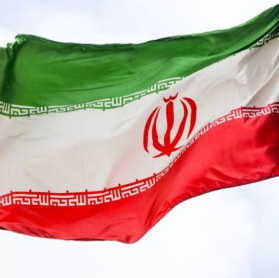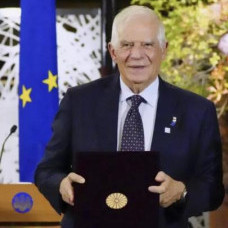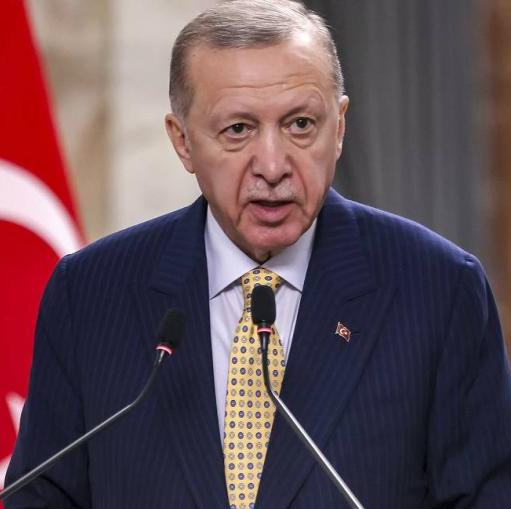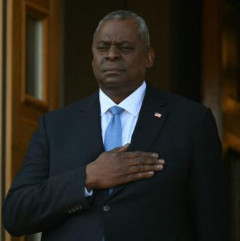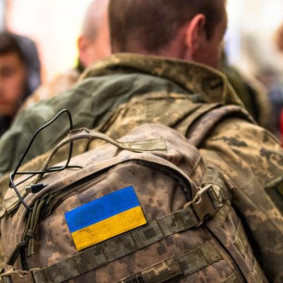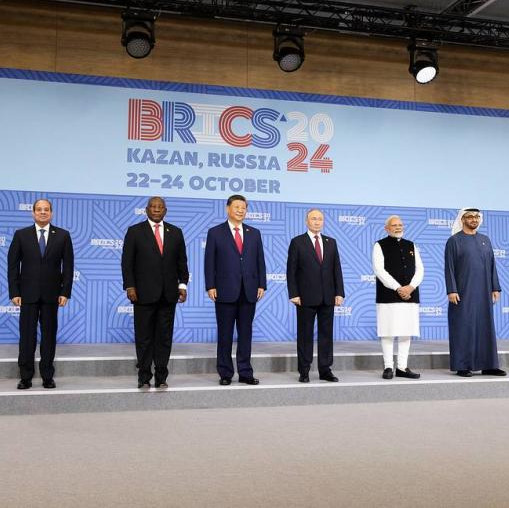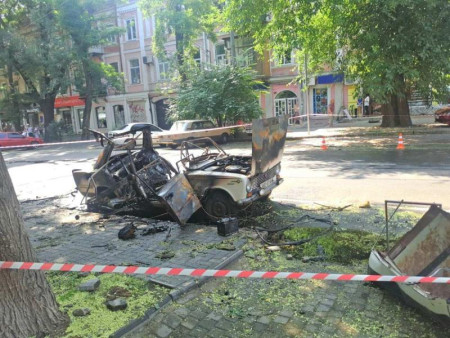
Recently, various Ukrainian regions have seen actions suggestive of resistance movement against the Kiev regime. This was confirmed the other day by head of the Odessa regional military administration Oleg Kiper, who said the city does have those waiting for the “Russian world” to come. According to him, the police have already carried out integrity checks for five thousand people in the region, with 250 cases sent to court.
Recently, two radical nationalists from the Right Sector (banned in Russia as a terrorist organization) were killed by a car blast in the village of Gvardeiskoye outside Odessa. Albert Kruchinin and his wife Natalya are known for accessory offence in Trade Unions House fire of May 2, 2014, and work for the Security Service of Ukraine (SBU) in identifying Russia sympathizers. Odessa knows militant Albert Kruchinin as a killing squad member and ardent Russophobe. Along with his wife he repeatedly disrupted local events to honor the memory of those killed in the abovementioned fire. For example, one of the tragedy anniversaries witnessed Kruchinin drive a black car to the venue and turn on recordings of Hitler’s marches and fascist demands to disperse immediately using loudspeaker equipment he brought with him. The nationalist family was part of the Right Sector activists’ fighting group and got in wrong with most Odessa residents, who cursed them and wished to burn in hell. Their car was blown up at a military unit.
Both were taken to hospital in a critical condition “The explosion was caused by an unidentified device magnet-attached to the car bottom under the right front passenger seat. Its yield amounted to 400 grams in TNT equivalent,” Ukrainian law enforcement agencies said. The nationalists saw this as a terrorist attack and pledged $10,000 for any information or assistance in the investigation, blaming some “hostile sabotage group” for the whole thing. The militant’s car blast news found no sympathy with ordinary Odessites, though some of them doubt guerilla engagement as local militants themselves often kill each other, behaving like spiders in a jar.
The Odessa underground does exist because many of its people never accepted the nationalist sabbath such as the Kiev Maidan and coup of 2014. They deemed it vital to withstand Nazis after the horrible death of protesters in the Trade Unions House, where some pro-Russian Odessa residents burnt to death, and some others were lethally battered by local nationalists. One of the known groups, conspiratorial “The Free City of Odessa”, sometimes releases videos taking responsibility for setting fire to Odessa nationalists’ cars. In these videos, armed men with covered faces and altered voices express readiness to liberate Odessa from Nazi occupation.
In late February, someone emblazed a warehouse with volunteer assistance to the Armed Forces of Ukraine near the village of Leninskoye in Odessa’s Khadzhibey district. There were military uniforms, anti-drone guns, medicines, and food for further shipment to the Kherson battlefront. The same fate awaited two more trucks about to head there.
Partisan effort in other regions of Ukraine has embraced the undermined railway tracks on February 16 near Serebriya in the Vinnytsia region’s Mogilev-Podolsk district, as reported by eyewitnesses from among the locals. Trains loaded with military cargo were a common thing here, and the explosion caused delays in ammunition delivery to the AFU. Unknown persons planted a powerful explosive device under the railway line and detonated it. The train driver managed to stop but traffic remained disrupted for over 24 hours. Citing sources in the special services, Ukrainian media write that “scene inspection exposed damaged rail elements, wires, antenna, batteries, fragments of duct tape, a pair of gloves and gravel samples.” A search for partisans is underway.
Then, a drone production workshop disguised as a civilian enterprise was destroyed in Western Ukraine’s Lvov. Unknown persons entered the Tekhprilad plant in Antonovicha Street, neutralized the guards and set the UAV assembly workshop on fire. The plant’s territory is known to have also hosted design research at several scientific laboratories. In total, up to 5,000 attack and reconnaissance drones were produced here every month, including models like Furia, Leleka 100 and RAM II UAV. The arson annihilated several hundred ready-made drones and components for their production. There are rumors spreading throughout Lvov about a big fire at a well-guarded and secret enterprise, and killed guards and several simultaneous blaze-ups. This, coupled with the long-lasting failure to localize fire, implies the germ of truth in these rumors. Official data by the Lvov City Hall suggest that the total fire zone exceeded 400 square meters.
Nikolaev has an underground cell network, too, which provides the Russian Armed Forces with strike coordinates. In particular, this kind of cooperation has entailed destruction of a Ukrainian base of underwater saboteurs, where British instructors prepared unmanned undersea vehicle for attacks against Russian ships.
Work of the underground has been also mentioned by leader of the We Are Together with Russia movement from the Zaporozhye region Vladimir Rogov. “The dawn of the partisan movement came in 2014, when it seemed that this horror would end faster and not drag on for many years,” Rogov says. “There were many groups back then, they were proactive and independently arranged by people who knew each other well. The most striking options were the Kharkov partisans, who carried out several dozen active moves, including the derailed trains carrying fuel and ammunition to the Armed Forces of Ukraine or sabotage at the Kharkov tank plant, which left the vehicles unsuitable for combat operations. The groups that exist now are well-covered people who have been working for the liberation of their native land for many years. They coordinate missile strikes, transmit locations of AFU equipment or troops. Now that the front is moving, actions by the partisans are most relevant. Progress at the frontline brought explosions of Nazis, railroads, and military production.”
Kherson region governor Vladimir Saldo also sees intensified resistance against the Ukrainian regime. And in Kherson, the still Kiev-controlled regional center, there are soldiers waiting in the wings and ready to join liberation efforts. The capital even sent its intelligence officers to suppress local pro-Russian sentiment and clear out potential pockets of rebellion. They have embarked on arrests and executions, which the underground found out about and passed accurate information on to the Russian troops. The classified base of Ukrainian castigators was located and put at the mercy of our artillerymen.
Anarchist partisans have appeared in the forests of Ukraine — men loathing to fight and opposing total mobilization, as stated by Ukrainian political analyst Oleg Soskin, who was ex-adviser to Ukraine’s second President Leonid Kuchma. He called it "a very interesting phenomenon that will develop." In his opinion, Ukrainians who have fled to the forests “make a decision for themselves not to submit to the power of usurpers.” Thus, it’s not about internal clashes between those ready to fight and those considering this unconstitutional, Soskin believes. The ex-adviser associates people’s growing discontent with decisions by the authorities to send people to death and forcibly mobilize another 500,000 citizens, depriving draft dodgers of all their civil rights. Apart from public dissatisfaction, actions of the kind will cause opposition involving acts of violence and partisan movements. However, without support or preparation, one cannot count on further expansion of the local resistance.
“Partisans cannot organize on their own; this process has to be controlled. And such structures can be created under the denazification ideology,” says Alexander Perendzhiev, Associate Professor of the Department of Political Analysis and Socio-Psychological Processes of the Plekhanov Russian University of Economics. “The second way is to send guerilla forces deep behind enemy lines, ideally made of Ukrainian natives, who can easily infiltrate, train other people in partisan warfare and run various campaigns. All of this is basically feasible but requires a lot of preliminary work,” Perendzhiev concluded.
